
Ficus Shivereana thrives in bright, indirect light. A spot near a window with filtered sun light is ideal, as too much direct sun can scorch its delicate variegated leaves. While it can tolerate lower light conditions, its growth may slow, and its stunning variegation may become less visible. If natural light is insufficient, consider supplementing with a grow light to maintain its vibrant appearance.
Like most Ficus varieties, Ficus Shivereana prefers a consistent watering schedule. Water when the top 1-2 inches of soil feel dry, ensuring the plant never sits in soggy soil, as this can lead to root rot. Reduce watering frequency in the winter when the plant's growth slows. Always use a pot with drainage holes to prevent excess moisture from accumulating at the roots.
Ficus Shivereana thrives in a well-draining, aerated potting mix. A mix containing peat, perlite, and orchid bark works well to provide the right balance of moisture retention and drainage. Repot the plant every 1-2 years or when it outgrows its current pot, as this will promote healthy root development and continued growth.
This tropical plant prefers warm temperatures ranging from 65-80°F (18-27°C) and does not tolerate cold drafts or sudden temperature fluctuations. Keep it away from air conditioning vents, heaters, and cold windows. Ficus Shivereana also enjoys moderate to high humidity, ideally above 50%. If your home is dry, especially in winter, increase humidity by misting the plant, using a pebble tray, or placing it near a humidifier.
Feed your Ficus Shivereana a balanced liquid fertilizer diluted to half strength every 4-6 weeks during the growing season (spring and summer). Avoid fertilizing in fall and winter when growth naturally slows. Be careful not to over-fertilize, as excess nutrients can cause leaf burn or weak, leggy growth.
Regular pruning helps maintain Ficus Shivereana’s shape and encourages bushier growth. Trim any yellow or damaged leaves to keep the plant looking its best. Wipe the leaves occasionally with a damp cloth to remove dust and improve photosynthesis. If your plant becomes too tall or leggy, you can trim back the stems, and new growth will emerge from the nodes.
Unfortunately, Ficus Shivereana is toxic to pets if ingested. It contains sap that can cause irritation and digestive distress in cats and dogs, so it’s best to keep it out of their reach.